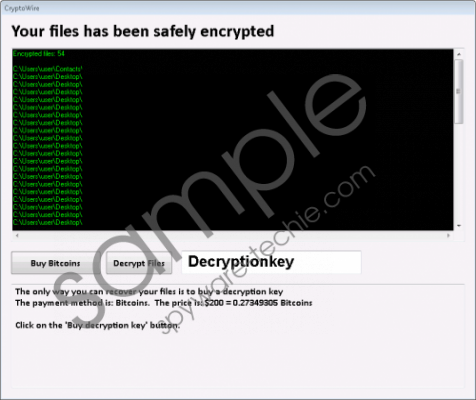Do you know what CryptoWire Ransomware is?
While some people are calling CryptoWire Ransomware an educational piece of software, you should know that it is nothing more than yet another malware that you should avoid at all costs. One of the most suspicious things regarding this ransomware is the fact that it is up for a public download and can even be edited to particular needs. This is highly threatening as cyber criminals can obtain and modify this malicious application. Even though alterations of it are possible, it remains an application classified as a ransomware because of its basic capability to encrypt data without a user's consent. If, unfortunately, you already have CryptoWire Ransomware up and running on your operating system do not hesitate to remove it by following the detailed instructions that we present below. To learn how you can safeguard your PC from this or any other malicious program and to find out more about its complex inner workings, be sure to read the rest of our report.
Upon intrusion, CryptoWire Ransomware does a number of things that corresponds which each other in order for this malware to fully functiion. Firstly, it creates an exact copy of itself and drops it within the %PROGRAMFILES(x86)%\Common Files folder. This executable file is important since this application also creates a task within the %WINDIR%\System32\Tasks that is directly linked to the mentioned malicious file. Thus, this interconnection between the devious file and a newly created Windows task manifests as an auto-start of the ransomware in question upon each system start-up. After this is done, the malicious program does one more thing before it starts locking up your data: it deletes all the shadow copies of your files from your machine, making your files unrecoverable even before actually encrypting them. The whole encryption procedure itself is completely silent. During the research, our malware experts, have discovered that this malicious program has an effect on the .exe files. This means that once this devious application is done doing its dirty work chances are that not only valuable data will be locked, but quite a few of your third-party and even native Windows applications might be unusable. It is essential to note that as up now this ransomwate does not affect files that exceed 30MB, but that could be changed by malware developers soon. Once the encryption has taken place, you will be presented with a ransom note asking for payment in BitCoins for an exchange of a decryption tool. We highly advise you not to do because a free-for-all decryption application is already in makings and will be available to the public shortly. Such functionality of CryptoWire Ransomware should be enough to make you realize that its complete removal is crucial, but you should also be informed that in some instances this malware could be used by other potentially harmful programs as a backdoor into your operating system. Make sure to remove it at the very same time that it is found up and running on your personal computer. CryptoWire Ransomware screenshot
CryptoWire Ransomware screenshot
Scroll down for full removal instructions
It has been highlighted that usually, CryptoWire Ransomware functions in an entirely silent manner, meaning that a user with no advance computer knowledge, will not have a clue of what is going on. To avoid finding yourself in such a situation and to maintain a fully secure operating system at all times you must take steps to improve your overall virtual security. First and foremost, make sure to install a licensed antimalware tool if you do not have one already since it is capable of detecting and removing any virtual threat in an automated manner. Such a tool is the most important part of your operating system's security. Additionally, we recommend avoiding all e-mail attachments coming your way from unknown senders because it is a common practice used by malware developers to spread their malicious software. Also, refrain yourself from suspicious third-party websites as they could be infested with harmful applications disguised as something trustworthy. Always acquire a program that you wish to run on your PC from an official developer's website only. By taking these precautionary steps, you will be able to dramatically lower the risk of infecting your PC with some unknown malware.
The complete removal of CryptoWire Ransomware should be immediate yet carefully executed since leftovers could be utilized in devious ways. In some instances, traces of this ransomware could simply restore it, in other cases they could prove to be enough for it to continue its harmful functionality. This is the main reason, malware experts at Spyware-Techie.com urge you to double-check your PC after a manual removal is executed. Look for anything linked to CryptoWire Ransomware; if anything is found terminate it immediately. This way you will be sure that the malware in question has been removed in its entirety.
How to remove CryptoWire Ransomware from your PC
- Open the File Explorer.
- Navigate to C:\User\[your username]\Downloads.
- Find and remove a malicious .exe file. Usually the name of this file is randomized .
- Navigate to C:\Program Files(x86)\Common Files.
- Locate and then remove the malicious executable file. This file's name is randomized as well.
- Navigate to C:\Windows\System32\Tasks.
- Find and then delete a malicious task. The name of this file is combined of 10 random digits.
In non-techie terms:
If you believe that manual removal is a bit too complicated since you will have to identify files within the Windows file system on your own, do not worry. Our researchers working at our internal labs have crafted an alternative removal guide that we present below. Follow these instructions and you will be able to delete CryptoWire Ransomware automatically and will not have to conduct a manual analysis for its potential leftovers.
